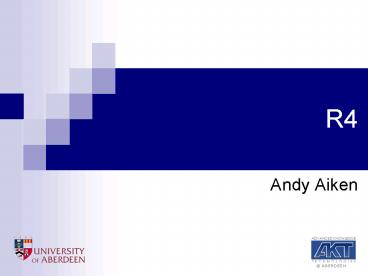R4 - PowerPoint PPT Presentation
1 / 29
Title: R4
1
R4
- Andy Aiken
2
Overview
- The Refiner series
- Cognitive psychology of diagnosis
- Diagnosis Web
- Proposed work R4
3
The Refiner Series
- Case-based system
- Cases are assigned to categories
- System generates descriptions of these categories
- Resolves inconsistencies in datasets
- An inconsistency is when a case does not only
match the category it has been assigned to by an
expert - User-directed
4
The Refiner Series
- History
- Refiner initial system (1988)
- Refiner batch system (1995)
- Much more efficient
- Refiner current version
- Java, faster, more strategies and data types, GUI
- Evolution not revolution
5
The Refiner Series
6
The Refiner Series
- Refiner was shown to experts
- Anaesthetics, child psychology, HDU, medical CAL,
engineering - Reaction was generally positive
- System to be used in several proposed
interdisciplinary projects - BUT
7
The Refiner Series
- Limitations
- Time Series
- Many medical datasets, for example, are
time-series data - Noise
- Can deal with noise, but in a limited and
sometimes confusing way - This is our focus
8
Refiner and Noise
- What changes are needed?
- Changes the focus of the system
- Refiner the creation of category descriptions
- R4 classification
- This requires us to investigate the science of
diagnosis
9
Diagnosis
- How do clinicians perform diagnosis?
- How is it taught?
- What is the cognitive psychology?
10
Diagnosis
- Differential Diagnosis
- What is a differential diagnosis?
- Requires the diagnostician to memorise a vast
amount of information - Simplistic view of the process
11
Diagnosis
12
Diagnosis
- Hypothetico-Deductive Reasoning
- Uses both forward and backward chaining
- Iterative
- Requires significant cognitive processing
13
Diagnosis
- Given initial facts, work forward to likely
hypotheses - These are the differential diagnoses
Facts
Hypotheses
14
Diagnosis
- Identify other facts which should be present for
these hypotheses to hold, and investigate them - Can attempt to distinguish between a set of
competing hypotheses, or get additional
confirmation for a hypothesis
Facts
Hypotheses
15
Diagnosis
- Repeat until satisfied
- One hypothesis is notably more likely than others
- One likely hypothesis is especially significant
- The courses of action are similar
Facts
Hypotheses
16
Diagnosis
- The effect of expertise
- Novices perform HDR, but the process is slow,
potentially incomplete and inaccurate - Intermediates perform HDR, but this is still a
slow process - Experts still perform HDR but this is
supplemented by compiled knowledge (shortcuts
faster)
17
Diagnosis
- Illness Scripts (Feltovich, 1984)
- Compiled knowledge used in diagnosis
- Comprises three knowledge sources
- Faults
- Consequences
- Enabling conditions
- Says nothing about how they are used
18
Diagnosis
- Faults
- The underlying malfunctions which give rise to
the symptoms - Consequences
- Detectable signs and symptoms
- Enabling conditions
- Background knowledge
- Predisposing factors (patients case history)
- Boundary conditions (age and gender)
- Hereditary factors
19
Diagnosis
- Illness scripts dont explain the process of
diagnosis - Diagnosis Web
- A more inclusive explanation
- More knowledge sources
- Links between them indicate processes
20
Diagnosis Web
21
Diagnosis Web
- How do we use the diagnosis web to improve the
Refiner series?
22
R4
- Will be aimed at novice diagnosticians
- Medical students, but not limited to medical
domains - An aid to diagnosis
- Supports the students reasoning without taking
over
23
R4
- Three stories
- An aid to diagnosis
- Scaffolding users diagnostic skill
- Generation of test cases
24
R4
- User presents a case to the system
- The system displays two lists
- Likely (differential) diagnoses
- Potential next steps (descriptors to find values
for) to hone in on the correct diagnosis - Providing more data for the case updates these
lists automatically
25
DXplain
26
DXplain
- Used by clinicians to perform diagnosis
- User enters findings, system updates lists of
likely diagnoses and other findings to be
investigated - Sound familiar?
27
R4 and DXplain (et al)
- Superficially very similar
- R4 is case-based others are database-driven
- Easier to create maintain a casebase
- R4 uses descriptor values others are term-based
- Lends itself to automation
- No other system attempts to mirror the cognitive
process of diagnosis
28
Conclusion
- Refiner was well received but did not handle
noisy datasets well - Adding the facility to handle noisy datasets
changes the focus to classification - Combining HDR and illness scripts leads to the
Diagnosis Web - The new Refiner system will incorporate aspects
of HDR and illness scripts to mirror how
diagnosis is performed
29
Questions?































